HISTORY OF U.S.S. FLORIDA
Named for the 27th State of the Union, admitted to the Union on 03 March 1845
I
The first Florida was a sloop, which served on survey duty on the southern coast of the United States between 1824 and 1831. Her final cruise, between 1 June 1830 and 31 May 1831, was under the command of Lieutenant T. R. Gedney
II
The second Florida, a sidewheel steamer, was purchased and commissioned on 05 October 1861, with Lieutenant J. R. Goldsborough in command.
When commissioned, the sidewheel steamer displaced 1,261 tons; was 214' in length; had a beam of 35'3"; drew 22'4" of water; could make 13 knots of speed; and was armed with 8 32-pounders forward and 1 20-pounders in the rear.
Florida stood out of New York Harbor 19 October 1861 to join the South Atlantic Blocking Squadron in patrolling the coasts of South Carolina, Georgia, and Florida. She helped capture a ship and a schooner who were running the blockade. Returning to New York during November, 1862 she was decommissioned for repairs, and was recommissioned 07 March 1863 for service with the North Atlantic Blockading Squadron. She was particularly succesful in this assignment, capturing a steamer and a schooner off Wilmington, NC, in June 1863, and aiding the destruction of a number of British steamers used as blockade runners in February 1864.
Again out of commission for repairs between 12 December 1864 and 26 February 1865, Florida sailed 10 March 1865 with supplies for ships on station along the Atlantic coast. She proceeded through the Gulf of Mexico to New Orleans where she embarked Confederate Prisoners from the ram CSS Webb, transporting them to New York. Florida weighed anchor again to cruise the Gulf of Mexico until the end of 1865.
On her final voyage, Florida sailed in the West Indies from 04 January 1866 to 08 January 1867. She was placed out of commission for the last time on 26 April 1867 and subsequently sold.
III
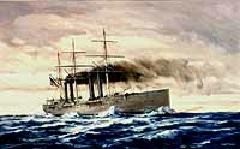 The third Florida, orginally named the USS Wampanoag -- a screw frigate -- was laid down on 3 August 17863 by the New York Navy Yard, New York;
launched on 15 December 1864; sponsored by Miss Cast, daughter of Capt. Augustus Ludlow Case,
second-in-command of the navy yard; and commissioned on 17 September 1867, Capt. J. W. A. Nicholson in
command.
The third Florida, orginally named the USS Wampanoag -- a screw frigate -- was laid down on 3 August 17863 by the New York Navy Yard, New York;
launched on 15 December 1864; sponsored by Miss Cast, daughter of Capt. Augustus Ludlow Case,
second-in-command of the navy yard; and commissioned on 17 September 1867, Capt. J. W. A. Nicholson in
command.
When commissioned the Wampanoag had a Displacement, 4,215; Length, 355'; Beam, 45'2"; Draft, 19'; Speed, 19 knots; Armament, ten 8" smooth bore, two 100-pdrs., two 24-pdr howitzers, two 12-pdr. Howitzers, one 60-pdr. rifle pivot.
Commerce raiding by CSS Alabama and CSS Florida, both built in English yards, reached a point in 1863 where
continued peaceful relations between the United States and Great Britain were seriously jeopardized. As a result, Congress responded by authorizing construction of a new class of screw frigates as part of the naval procurement bill of that year. These vessels, designed to be the fastest in the world, were intended for use in hit-and-run operations against British ports and commerce in the event of war. Wampanoag was the lead ship of this class.
Wampanoag contained numerous design features unprecedented in American naval construction. Her hull --
designed by clipper ship architect B. G. Delano -- was unusually long and tapered relative to the vessel's beam. Her machinery, developed by controversial Naval Engineer B. F. Isherwood, was unique for its geared steam engine in which slow-moving machinery coupled to fast-moving propulsion gear. Tremendous debate caused by this design delayed construction, preventing Wampanoag from being completed in time to serve in the Civil War.
The screw frigate finally left New York for sea trials on 7 February 1868. On 11 February, she commenced speed tests, running flat-out in rough weather from Barnegat Light, New Jersey, to Tybee Island, Georgia. She covered the distance of 788 miles in 38 hours for an average sustained speed of 16.6 knots, at one point making 17.75 knots. Another naval vessel, American cruiser Charleston, did not equal this record for 21 years.
From 22 February 1868 to 8 April, Wampanoag was deployed as flagship of the North Atlantic Fleet. On 5 May
1868, she decommissioned at the New York Navy Yard. Wampanoag was renamed Florida on 15 May 1869.
The controversy generated by the frigate's unconventional design reached a peak in 1869 when a naval Admiral R. M. Goldsborough, Commodore Charles S. Boggs, and Engineers E. D. Robie, John W. Moore, and Isaac Newton judged the ship unacceptable for active duty in the Navy. They complained of her unusually large machinery spaces, heavy coal consumption, and found particular fault with her narrow breadth relative to her length. The commission said this caused inordinate rolling and straining of the vessel. As a result, Florida remained in ordinary at New York for five years before departing on 5 March 1874, bound for New London, Connecticut, to become a receiving and store ship at the Naval station there.
Florida remained at New London, rotting, until February 1885. She was sold, at New York, on 27 February 1885 to Edwin LeBars.
IV
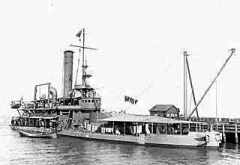 The fourth Florida, Monitor No. 9, was launched 30 November 1901 by Lewis Nixon, Crescent Shipyard, Elizabethport, NJ; sponsored by Miss S. Wood; and commissioned 18 June 1903, with Commander J. C. Fremont in command.
The fourth Florida, Monitor No. 9, was launched 30 November 1901 by Lewis Nixon, Crescent Shipyard, Elizabethport, NJ; sponsored by Miss S. Wood; and commissioned 18 June 1903, with Commander J. C. Fremont in command.
When commissioned, the monitor (BM-9) displaced 3,225 tons; was 252' in length; had a beam of 50'; drew 12'6" of water; could make 12 knots of speed; and was armed with 2 12" guns, 3 4"guns, and 1 3" gun.
Serving with the Coast Squadron, Florida trained midshipman on summer cruises, and operated along the east coast and in Caribbean waters. She participated in the Presidential Naval Review in Oyster Bay, Long Island, held by Theodore Roosevelt on 03 September 1906, and four days later reported to the Naval Academy for regular service as a practice ship. She was placed in reserve 11 September 1906 but returned to full commission between 07 June and 30 August 1907 for a midshipman cruise, and between 21 May and 19 June 1908 for participation in ordance experiments.
On 01 July 1908 Florida was renamed Tallahassee to free the State name for assignment to a battleship. On 01 August 1910 she was placed in commission in reserve and began a regular schedule of ordnance experimentation and occasional duty in the Canal Zone and Norfolk area as a submarine tender. During World War I she served as a submarine tender in the Canal Zone, the Virgin Islands, and Bermuda areas and on 30 September 1919 entered Charleston Navy Yard where she was decommissioned on 03 December 1920. Tallahassee was assigned to the 6th Naval District as a reserve training ship from 19 February 1920, serving in commissioned status from 03 September 1920 to 24 March 1922. She was sold at Philadelphia on 25 July 1922.
V
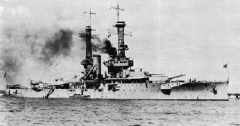 The fifth Florida (BB-30) was launched 12 May 1910 at the New York Navy Yard, sponsored by Miss E. D. Fleming, daughter of a former Florida Governor; and commissioned 15 September 1911, Captain H. S. Knapp in command.
The fifth Florida (BB-30) was launched 12 May 1910 at the New York Navy Yard, sponsored by Miss E. D. Fleming, daughter of a former Florida Governor; and commissioned 15 September 1911, Captain H. S. Knapp in command.
When commissioned, the battleship (BB-30) displaced 21,825 tons; was 521'6" in length; had a beam of 88'3"; drew 28'4" of water; could make 21 knots of speed; was maned by 1,001 officers and men; and was armed with 10 12" guns, 16 5" guns, and 2 21" torpedo tubes. She was the lead ship of the Florida Class.
After extensive training in the Caribbean and Maine coastal waters, Florida arrived in Hampton Roads, VA, 29 March 1912 to join the Atlantic Fleet as Flagship of Division 1. Regularly scheduled exercises, maneuvers, fleet training and target practice, and midshipmen training cruises took the new battleship to many east coast ports and into Caribbean waters. Early in 1914
tension heightened between the United States and factions in Mexico and Florida arrived off Vera Cruz on 16 February 1914 remaining there during the ensuing occupation. She steamed to New York in July to resume regular Fleet operations and in October was transferred to Division 2.
Following United States entry into World War I, Florida completed exercises in the Chesapeake Bay and proceeded with Battleship Division 9 to join the British Grand Fleet at Scapa Flow, Orkney Islands, on 07 December 1917. She participated in the Grand Fleet maneuvers and evolutions, and performed convoy duty with the 6th Battle Squadron of the Grand Fleet through the remainder of the war. She rendezvoused with the Grand Fleet on 20 November 1918 when it met to escort the German High Seas Fleet into the Firth of Forth.
Florida joined the escort for George Washington, President Woodrow Wilson embarked, as she proceeded into Brest, France on 12 and 13 December 1918. She participated in the grand Victory Naval Review in the North River, New York City, in late December and then returned to Norfolk 04 January 1919 to resume peace time operations. During May she cruised to the Azores and took weather
observations for the first aerial crossing of the Atlantic achieved that month by Navy seaplanes.
Florida's operations during the remaining years of her career were highlighted by participation in the tercentennary celebration in August 1920 of the Pilgrims' landing at Provincetown, MA, a diplomatic voyage to South American and Caribbean ports with Secretary of State R. Lansing embarked,
service as flagship for Commander, Control Force, U.S. Fleet, amphibious operations with Marines in the Caribbean, and midshipman training cruises.
The USS Florida was laid up June 1924. She was modernized at the Boston Navy Yard from 01 April 1925 to 01 November 1926. The reconstruction included: Heavier deck armor and anti-torpedo blisters along her sides and a rearranged secondary gun battery. The four boilers were converted from coal fired to White-Forster oil fired. Her two smokestacks were trunked into one. The aft caged mast was replaced with a lower stick mast and relocated aft between Turrets 3 & 4. Four of the sixteen 5" 45 caliber secondary battery mounted in sponsons in the hull were removed. The two 21" underwater mounted torpedo tubes were also removed. The ship served but a few years in this new guise, as she had to be removed from the National Armament under the 1930 London Naval Limitations Treaty.
Therefore, she was decommissioned 16 February 1931 at the Philadelphia Naval Yard, strickened from the list 06 April 1932 and scrapped at the Philadelphia Naval Yard under the terms of the London Naval Treaty of 1930. Scrapping was completed on 30 September 1932.
VI
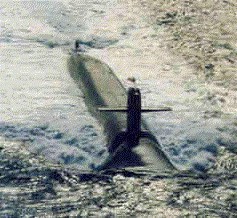 The sixth Florida(SSBN 728), the third of the Ohio-Class Trident submarines, was laid down 04 July 1976; launched 14 November 1981; sponsored by Mrs. Marcia Myers Carlucci; and commissioned 18 June 1983, Captain W. I. Powell in Command, Blue Crew; and Captain G. R. Sterner in Command, Gold Crew.
The sixth Florida(SSBN 728), the third of the Ohio-Class Trident submarines, was laid down 04 July 1976; launched 14 November 1981; sponsored by Mrs. Marcia Myers Carlucci; and commissioned 18 June 1983, Captain W. I. Powell in Command, Blue Crew; and Captain G. R. Sterner in Command, Gold Crew.
When commissioned, the submarine was 560 feet in length; displaced 16,764 tons surfaced and 18,750 tons submerged; had a hull diameter of 42 feet; drew 36 feet of water; had 24 missile tubes; was manned by 17 officers, 15 Chief Petty Officers and 122 enlisted men E6 and below, a total of 154.
USS Florida is currently homeported at Naval Submarine Base, Bangor, WA.
SOURCES
- Dictionary of American Naval Fighting Ships
- Volume II, Pages 418 & 419
- Superintendent of Documents
- Washington, DC, 1963
- Dictionary of American Naval Fighting Ships
- Volume II C-F, Pages 418 & 419
- Superintendent of Documents
- Washington, DC, 1977
Last Updated 29 July 2002

What's past is prologue
Click on any [Item] below to go to that page
[Return to BB-30 Home Port Page]
[History of USS Florida]
[Ship Photos]
[Crew Photos]
[Shipboard Life Photos]
[Programs]
[World War I Operations]
[Specifications]
[Ship's Company]
[E-Mail Addresses]
[Sources]
[Relics and Artifacts]
[Recruitment Posters]
[Glossary]
[Favorite Links]
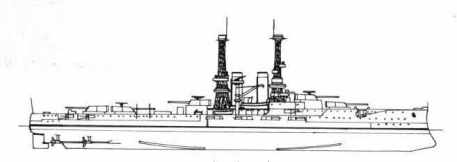 © 1998-2004 Benjamin M. Givens, Jr.
© 1998-2004 Benjamin M. Givens, Jr.

 The third Florida, orginally named the USS Wampanoag -- a screw frigate -- was laid down on 3 August 17863 by the New York Navy Yard, New York;
launched on 15 December 1864; sponsored by Miss Cast, daughter of Capt. Augustus Ludlow Case,
second-in-command of the navy yard; and commissioned on 17 September 1867, Capt. J. W. A. Nicholson in
command.
The third Florida, orginally named the USS Wampanoag -- a screw frigate -- was laid down on 3 August 17863 by the New York Navy Yard, New York;
launched on 15 December 1864; sponsored by Miss Cast, daughter of Capt. Augustus Ludlow Case,
second-in-command of the navy yard; and commissioned on 17 September 1867, Capt. J. W. A. Nicholson in
command.
 The fourth Florida, Monitor No. 9, was launched 30 November 1901 by Lewis Nixon, Crescent Shipyard, Elizabethport, NJ; sponsored by Miss S. Wood; and commissioned 18 June 1903, with Commander J. C. Fremont in command.
The fourth Florida, Monitor No. 9, was launched 30 November 1901 by Lewis Nixon, Crescent Shipyard, Elizabethport, NJ; sponsored by Miss S. Wood; and commissioned 18 June 1903, with Commander J. C. Fremont in command.
 The fifth Florida (BB-30) was launched 12 May 1910 at the New York Navy Yard, sponsored by Miss E. D. Fleming, daughter of a former Florida Governor; and commissioned 15 September 1911, Captain H. S. Knapp in command.
The fifth Florida (BB-30) was launched 12 May 1910 at the New York Navy Yard, sponsored by Miss E. D. Fleming, daughter of a former Florida Governor; and commissioned 15 September 1911, Captain H. S. Knapp in command.


